Study of the Mechanical Behavior of Dual-Phase Steel Based on Crystal Plasticity Modeling Considering Strain Partitioning
Abstract
:1. Introduction
2. Theory and Methodology
2.1. The Crystal Plasticity Model
2.2. Single-Crystal Viscous Model
2.3. Multiphase Hardening Model
3. Materials and Experiments
3.1. Materials and In Situ Stretch Experiment
3.2. Texture Measurement
4. Results and Discussion
4.1. Mechanical Behavior of DP800
4.2. Textural Evolution of DP800
4.3. Grain Deformation of DP800
5. Summary and Conclusions
- For DP800 steel, the initial strain of the soft ferrite phase is greater than the overall strain, which leads to the rapid hardening of the ferrite. This hardening phenomenon of ferrite promotes a higher overall hardening rate in early deformation, and this mechanism can explain the initial high hardening rate of DP steels.
- Probing the evolution of texture, the initial texture of DP steel is weak and grain orientations tend to be random. However, as the deformation increases, the DP steel tends to enhance the Rt-C texture.
- The plastic deformation of DP800 is mainly concentrated in the {112} <111> slip systems, and the activities of the slip systems are closely related to the crystal orientations. The average strain of each slip system is significantly different, but the average dislocation density is similar.
Author Contributions
Funding
Conflicts of Interest
References
- Kuziak, R.; Kawalla, R.; Waengler, S. Advanced high strength steels for automotive industry. Arch. Civ. Mech. Eng. 2008, 8, 103–117. [Google Scholar] [CrossRef]
- Tasan, C.C.; Diehl, M.; Yan, D.; Bechtold, M.; Roters, F.; Schemmann, L.; Zheng, C.; Peranio, N.; Ponge, D.; Koyama, M.; et al. An Overview of Dual-Phase Steels: Advances in Microstructure-Oriented Processing and Micromechanically Guided Design. Annu. Rev. Mater. Res. 2015, 45, 391–431. [Google Scholar] [CrossRef]
- Hardwick, A.P.; Outteridge, T. Vehicle lightweighting through the use of molybdenum-bearing advanced high-strength steels (AHSS). Int. J. Life Cycle Assess. 2016, 21, 1616–1623. [Google Scholar] [CrossRef]
- Bleck, W.; Papaefthymiou, S.; Frehn, A. Microstructure and Tensile Properties in Dual Phase and Trip Steels. Steel Res. Int. 2004, 75, 704–710. [Google Scholar] [CrossRef]
- Papaefthymiou, S.; Prahl, U.; Bleck, W.; Zwaag, S.V.D.; Sietsma, J. Experimental observations on thecorrelation between microstructure andfracture of multiphase steels. Int. J. Mater. Res. 2006, 97, 1723–1731. [Google Scholar] [CrossRef]
- Ghassemi-Armaki, H.; Maaß, R.; Bhat, S.P.; Sriram, S.; Greer, J.R.; Kumar, K.S. Deformation response of ferrite and martensite in a dual-phase steel. Acta Mater. 2014, 62, 197–211. [Google Scholar] [CrossRef]
- Yu, H.Y.; Shen, J. Evolution of mechanical properties for a dual-phase steel subjected to different loading paths. Mater. Des. 2014, 63, 412–418. [Google Scholar] [CrossRef]
- Mazaheri, Y.; Kermanpur, A.; Najafizadeh, A. Nanoindentation study of ferrite-martensite dual phase steels developed by a new thermomechanical processing. Mater. Sci. Eng. A 2015, 639, 8–14. [Google Scholar] [CrossRef]
- Rui, A.; Santosa, A.D.; Lopes, A. Mechanical properties determination of dual-phase steels using uniaxial tensile and hydraulic bulge test. Cienc. E Technol. Mater. 2017, 29, e239–e243. [Google Scholar]
- Paul, S.K.; Mukherjee, M. Determination of bulk flow properties of a material from the flow properties of its constituent phases. Comput. Mater. Sci. 2014, 84, 1–12. [Google Scholar] [CrossRef]
- Xiong, Z.P.; Saleh, A.A.; Kostryzhev, A.G.; Pereloma, E.V. Strain-induced ferrite formation and its effect on mechanical properties of a dual phase steel produced using laboratory simulated strip casting. J. Alloys Compd. 2017, 721, 291–306. [Google Scholar] [CrossRef]
- Kadkhodapour, J.; Butz, A.; Ziaei-Rad, S.; Schmauder, S. A micro mechanical study on failure initiation of dual phase steels under tension using single crystal plasticity model. Int. J. Plast. 2011, 27, 1103–1125. [Google Scholar] [CrossRef]
- Woo, W.; Em, V.T.; Kim, E.Y.; Han, S.H.; Han, Y.S.; Choi, S.H. Stress-strain relationship between ferrite and martensite in a dual-phase steel studied by in situ neutron diffraction and crystal plasticity theories. Acta Mater. 2012, 60, 6972–6981. [Google Scholar] [CrossRef]
- Kim, J.H.; Kim, D.; Barlat, F.; Lee, M.G. Crystal plasticity approach for predicting the Bauschinger effect in dual-phase steels. Mater. Sci. Eng. A 2012, 53, 259–270. [Google Scholar] [CrossRef]
- Prahl, U.; Papaefthymiou, S.; Uthaisangsuk, V.; Bleck, W.; Sietsma, J.; Zwaag, S.V.D. Micromechanics-based modelling of properties and failure of multiphase steels. Comput. Mater. Sci. 2007, 39, 17–22. [Google Scholar] [CrossRef]
- Kim, D.K.; Kim, E.Y.; Han, J.; Woo, W.; Choi, S.H. Effect of microstructural factors on void formation by ferrite/martensite interface decohesion in DP980 steel under uniaxial tension. Int. J. Plast. 2017, 9, 3–23. [Google Scholar] [CrossRef]
- Ogata, S.; Mayama, T.; Mine, Y.; Takashima, K. Effect of microstructural evolution on deformation behavior of pre-strained dual-phase steel. Mater. Sci. Eng. A 2017, 68, 353–365. [Google Scholar] [CrossRef]
- Tamura, I.; Tomota, Y.; Yamaoka, Y.; Kanatani, S.; Ozawa, M.; Akao, A. The Strength and Ductility of Two-phase Iron Alloys. Tetsu Hagane 1973, 59, 283–292. [Google Scholar]
- Araki, K.; Takada, Y.; Nakaoka, K. Work hardening of continuously annealed dual phase steels. Trans. Iron Steel Inst. Jpn. 1977, 17, 710–717. [Google Scholar]
- Tomota, Y.; Umemoto, M.; Komatsubara, N.; Hiramatsu, A.; Nakajima, N.; Moriya, A.; Higo, Y. Prediction of mechanical properties of multi-phase steels based on stress-strain curves. ISIJ Int. 1992, 32, 343–349. [Google Scholar] [CrossRef]
- Kuang, S.; Kang, Y.; Yu, H.; Liu, R.D. Stress-strain partitioning analysis of constituent phases in dual phase steel based on the modified law of mixture. Int. J. Miner. Metall. Mater. 2009, 16, 393–398. [Google Scholar] [CrossRef]
- Kang, J.; Ososkov, Y.; Embury, J.D.; Wilkinson, D.S. Digital image correlation studies for microscopic strain distribution and damage in dual phase steels. Scr. Mater. 2007, 56, 999–1002. [Google Scholar] [CrossRef]
- Ghadbeigi, H.; Pinna, C.; Celotto, S.; Yates, J.R. Local plastic strain evolution in a high strength dual-phase steel. Mater. Sci. Eng. A 2010, 527, 5026–5032. [Google Scholar] [CrossRef] [Green Version]
- Tasan, C.C.; Hoefnagels, J.P.M.; Geers, M.G.D. Microstructural banding effects clarified through micrographic digital image correlation. Scr. Mater. 2010, 62, 835–838. [Google Scholar] [CrossRef]
- Tasan, C.C.; Hoefnagels, J.P.M.; Diehl, M.; Yan, D.; Roters, F.; Raabe, D. Strain localization and damage in dual phase steels investigated by coupled in-situ deformation experiments and crystal plasticity simulations. Int. J. Plast. 2014, 6, 198–210. [Google Scholar] [CrossRef]
- Tasan, C.C.; Diehl, M.; Yan, D.; Zambaldi, C.; Shanthraj, P.; Roters, F.; Raabe, D. Integrated experimental–simulation analysis of stress and strain partitioning in multiphase alloys. Acta Mater. 2014, 8, 386–400. [Google Scholar] [CrossRef]
- Dan, W.J.; Lin, Z.Q.; Li, S.H.; Zhang, W.G. Study on the mixture strain hardening of multi-phase steels. Mater. Sci. Eng. A 2012, 55, 1–8. [Google Scholar] [CrossRef]
- Han, Q.; Asgari, A.; Hodgson, P.D.; Stanford, N. Strain partitioning in dual-phase steels containing tempered martensite. Mater. Sci. Eng. A 2014, 61, 90–99. [Google Scholar] [CrossRef]
- Chen, P.; Ghassemi-Armaki, H.; Kumar, S.; Bower, A.; Bhat, S.; Sadagopan, S. Microscale-calibrated modeling of the deformation response of dual-phase steels. Acta Mater. 2014, 6, 133–149. [Google Scholar] [CrossRef]
- Fillafer, A.; Krempaszky, C.; Werner, E. On strain partitioning and micro-damage behavior of dual-phase steels. Mater. Sci. Eng. A 2014, 61, 180–192. [Google Scholar] [CrossRef]
- Huang, T.T.; Gou, R.B.; Dan, W.J.; Zhang, W.G. Strain-hardening behaviors of dual phase steels with microstructure features. Mater. Sci. Eng. A 2016, 67, 88–97. [Google Scholar] [CrossRef]
- Sun, B.; Fazeli, F.; Scott, C.; Yan, X.; Liu, Z.; Qin, X.; Yue, S. Critical role of strain partitioning and deformation twinning on cracking phenomenon occurring during cold rolling of two duplex medium manganese steels. Scr. Mater. 2017, 13, 49–53. [Google Scholar] [CrossRef]
- Schwindt, C.D.; Bertinetti, M.A.; Iurman, L.; Rossit, C.A.; Signorelli, J.W. Numerical study of the effect of martensite plasticity on the forming limits of a dual-phase steel sheet. Int. J. Mater. Form. 2016, 9, 499–517. [Google Scholar] [CrossRef]
- Marin, E.B.; Dawson, P. On modelling the elasto-viscoplastic response of metals using polycrystal plasticity. Comput. Methods Appl. Mech. Eng. 1998, 165, 1–21. [Google Scholar] [CrossRef]
- Groh, S.; Marin, E.B.; Horstemeyer, M.F.; Zbib, H.M. Multiscale modeling of the plasticity in an aluminum single crystal. Int. J. Plast. 2009, 25, 1456–1473. [Google Scholar] [CrossRef]
- Roters, F.; Eisenlohr, P.; Hantcherli, L.; Tjahjanto, D.D.; Bieler, T.R.; Raabe, D. Overview of constitutive laws, kinematics, homogenization and multiscale methods in crystal plasticity finite-element modeling: Theory, experiments, applications. Acta Mater. 2010, 58, 1152–1211. [Google Scholar] [CrossRef]
- Hill, R. Generalized constitutive relations for incremental deformation of metal crystals by multislip. J. Mech. Phys. Solids 1966, 14, 95–102. [Google Scholar] [CrossRef]
- Hill, R.; Rice, J. Constitutive analysis of elastic-plastic crystals at arbitrary strain. J. Mech. Phys. Solids 1972, 20, 401–413. [Google Scholar] [CrossRef]
- Asaro, R.J.; Rice, J. Strain localization in ductile single crystals. J. Mech. Phys. Solids 1977, 25, 309–338. [Google Scholar] [CrossRef]
- Asaro, R.J.; Needleman, A. Overview no. 42, Texture development and strain hardening in rate dependent polycrystals. Acta Metall. 1985, 33, 923–953. [Google Scholar] [CrossRef]
- Taylor, G. Plastic strain in metals. J. Inst. Met. 1938, 6, 307–324. [Google Scholar]
- Hutchinson, J. Bounds and self-consistent estimates for creep of polycrystalline materials. Proc. R. Soc. Lond. A 1976, 348, 101–127. [Google Scholar] [CrossRef]
- Pan, J.; Rice, J. Rate sensitivity of plastic flow and implications for yield-surface vertices. Int. J. Solids Struct. 1983, 19, 973–987. [Google Scholar] [CrossRef] [Green Version]
- Harren, S. The finite deformation of rate-dependent polycrystals—I. A self-consistent framework. J. Mech. Phys. Solids 1991, 39, 345–360. [Google Scholar] [CrossRef]
- Paquin, A.; Berbenni, S.; Favier, V.; Lemoine, X.; Berveiller, M. Micromechanical modeling of the elastic–viscoplastic behavior of polycrystalline steels. Int. J. Plast. 2001, 17, 1267–1302. [Google Scholar] [CrossRef]
- Teodosiu, C.; Raphanel, J.L.; Tabourot, L. Finite element simulation of the large elastoplastic deformation of multicrystals. In Proceedings of the International Seminar MECAMAT’91, Fontainebleau, France, 7–9 August 1991. [Google Scholar]
- Lyu, H.; Ruimi, A.; Zbib, H. A dislocation-based model for deformation and size effect in multi-phase steels. Int. J. Plast. 2015, 7, 44–59. [Google Scholar] [CrossRef]
- Liao, J.; Sousa, J.A.; Lopes, A.B.; Xue, X.; Barlat, F.; Pereira, A.B. Mechanical, microstructural behavior and modelling of dual phase steels under complex deformation paths. Int. J. Plast. 2017, 9, 269–290. [Google Scholar] [CrossRef]
- Hatem, T.M.; Zikry, M. Dynamic shear-strain localization and inclusion effects in lath martensitic steels subjected to high pressure loads. J. Mech. Phys. Solids 2010, 58, 1057–1072. [Google Scholar] [CrossRef]
- Queyreau, S.; Monnet, G.; Devincre, B. Slip systems interactions in α-iron determined by dislocation dynamics simulations. Int. J. Plast. 2009, 25, 361–377. [Google Scholar] [CrossRef]
- Kitayama, K.; Tomé, C.N.; Rauch, E.F.; Gracio, J.J.; Barlat, F. A crystallographic dislocation model for describing hardening of polycrystals during strain path changes. Application to low carbon steels. Int. J. Plast. 2013, 4, 54–69. [Google Scholar] [CrossRef]
- Schwindt, C.; Schlosser, F.; Bertinetti, M.A.; Stout, M.; Signorelli, J.W. Experimental and Visco-Plastic Self-Consistent evaluation of forming limit diagrams for anisotropic sheet metals: An efficient and robust implementation of the M-K model. Int. J. Plast. 2015, 7, 62–99. [Google Scholar] [CrossRef]
- Anbarlooie, B.; Hosseini-Toudeshky, H.; Kadkhodapour, J. High cycle fatigue micromechanical behavior of dual phase steel: Damage initiation, propagation and final failure. Mech. Mater. 2017, 10, 8–19. [Google Scholar] [CrossRef]
- Wei, X.; Asgari, S.A.; Wang, J.T.; Rolfe, B.F.; Zhu, H.C.; Hodgson, P.D. Micromechanical modelling of bending under tension forming behavior of dual phase steel 600. Comput. Mater. Sci. 2015, 10, 72–79. [Google Scholar] [CrossRef]
- Zhou, J.; Gokhale, A.M.; Gurumurthy, A.; Bhat, S.P. Realistic microstructural RVE-based simulations of stress–strain behavior of a dual-phase steel having high martensite volume fraction. Mater. Sci. Eng. A 2015, 63, 107–115. [Google Scholar] [CrossRef]
- Ramazani, A.; Mukherjee, K.; Schwedt, A.; Goravanchi, P.; Prahl, U.; Bleck, W. Quantification of the effect of transformation-induced geometrically necessary dislocations on the flow-curve modelling of dual-phase steels. Int. J. Plast. 2013, 4, 128–152. [Google Scholar] [CrossRef]
- Rieger, F.; Wenk, M.; Schuster, S.; Bohlke, T. Mechanism based mean-field modeling of the work-hardening behavior of dual-phase steels. Mater. Sci. Eng. A 2017, 68, 126–138. [Google Scholar] [CrossRef]
- Ha, J.; Lee, J.; Kim, J.H.; Lee, M.G.; Barlat, F. Investigation of plastic strain rate under strain path changes in dual-phase steel using microstructure-based modeling. Int. J. Plast. 2017, 9, 89–111. [Google Scholar] [CrossRef]
- Jia, N.; Peng, R.L.; Chai, G.C.; Johansson, S.; Wang, Y.D. Direct experimental mapping of microscale deformation heterogeneity in duplex stainless steel. Mater. Sci. Eng. A 2008, 491, 425–433. [Google Scholar] [CrossRef]
- Saleh, A.A.; Pereloma, E.V.; Gazder, A. Microstructure and texture evolution in a twinning-induced-plasticity steel during uniaxial tension. Acta Mater. 2013, 61, 2671–2691. [Google Scholar] [CrossRef] [Green Version]



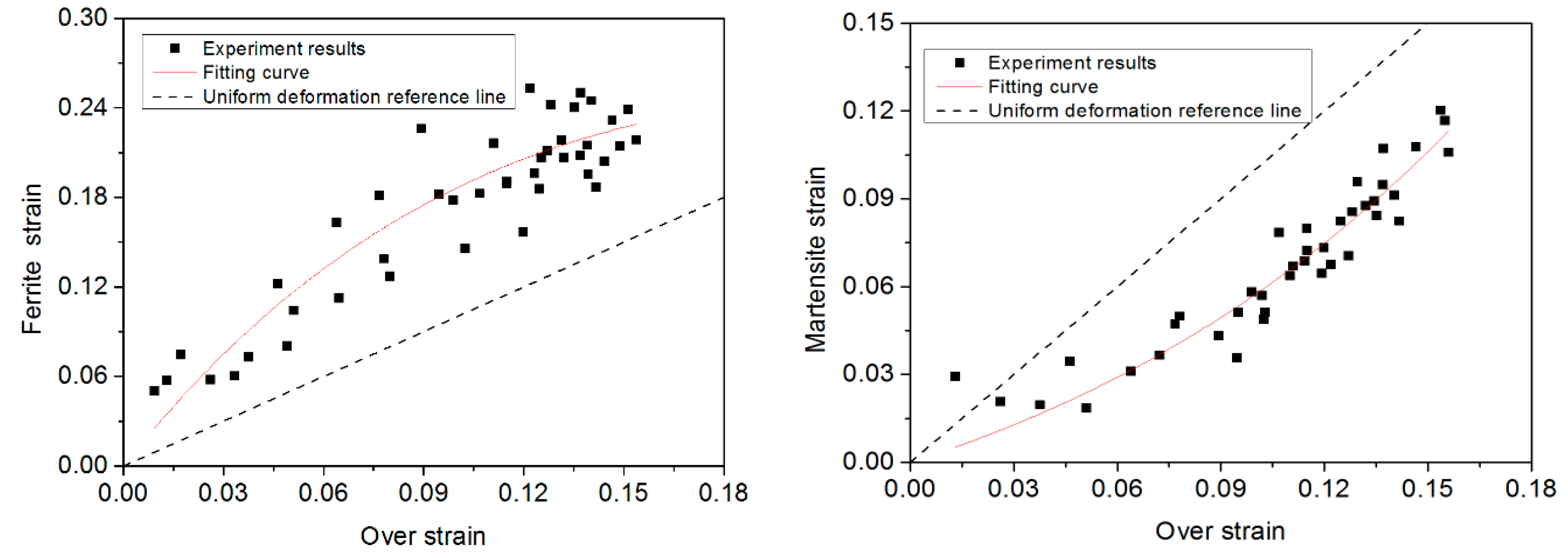
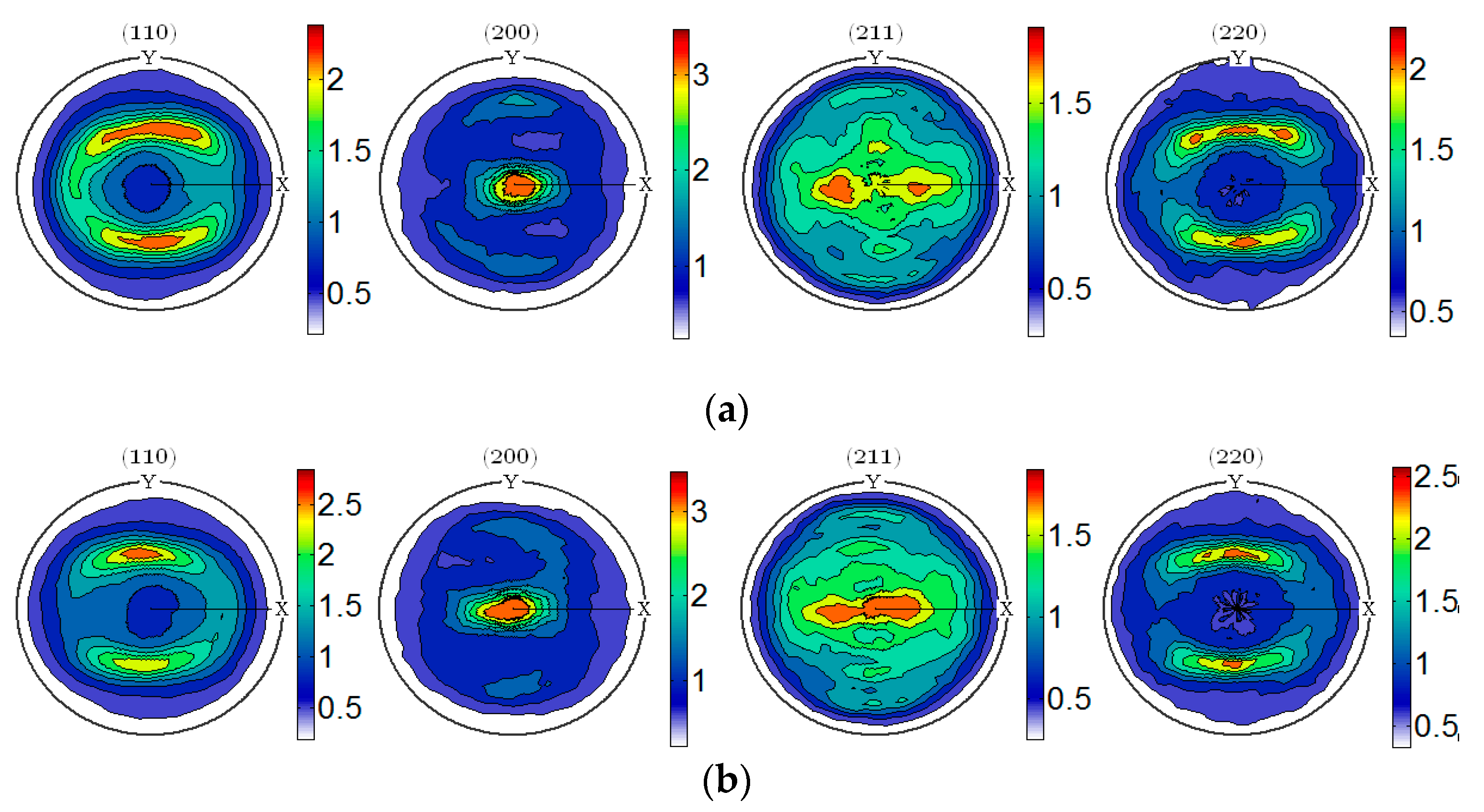
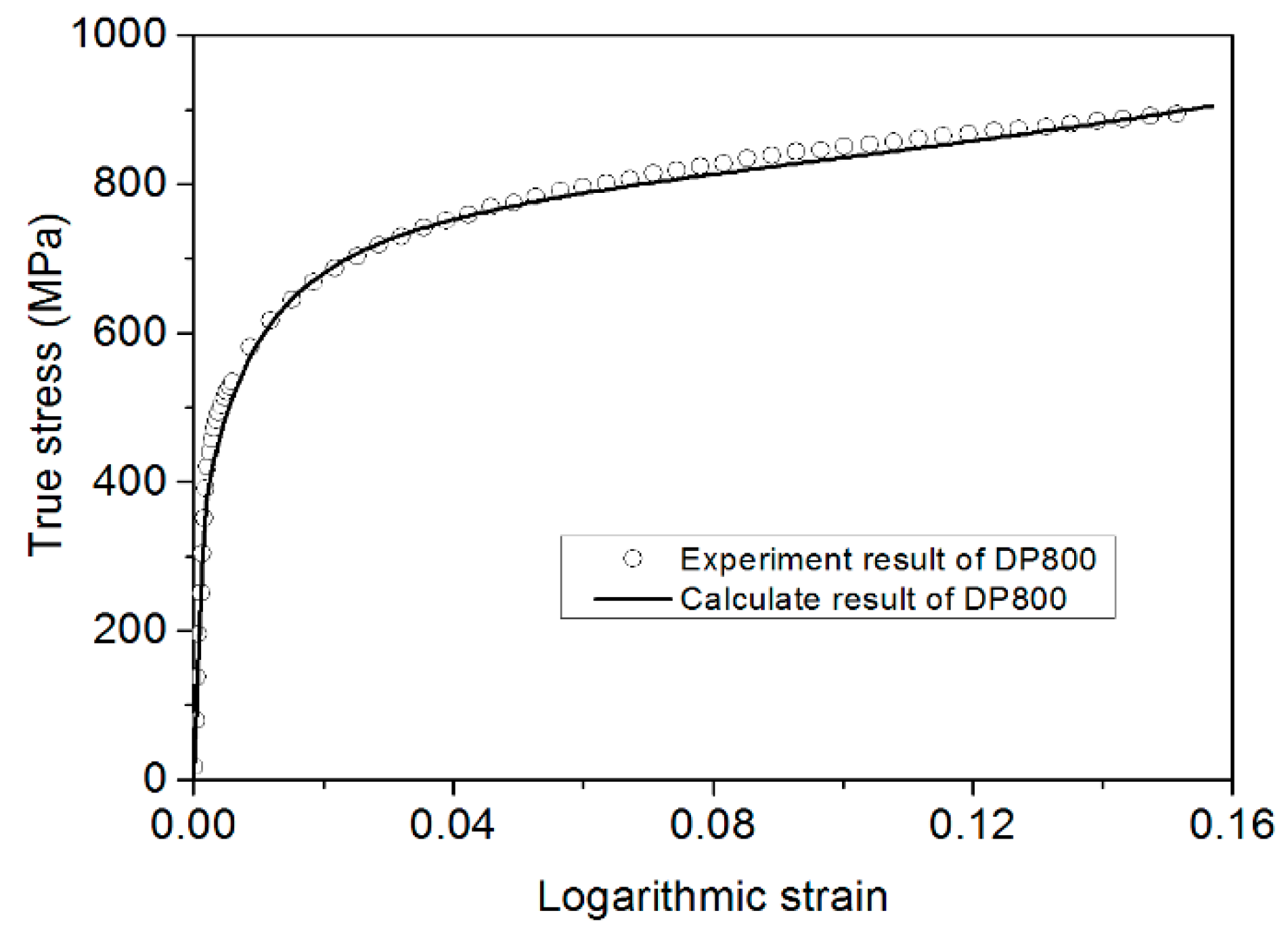
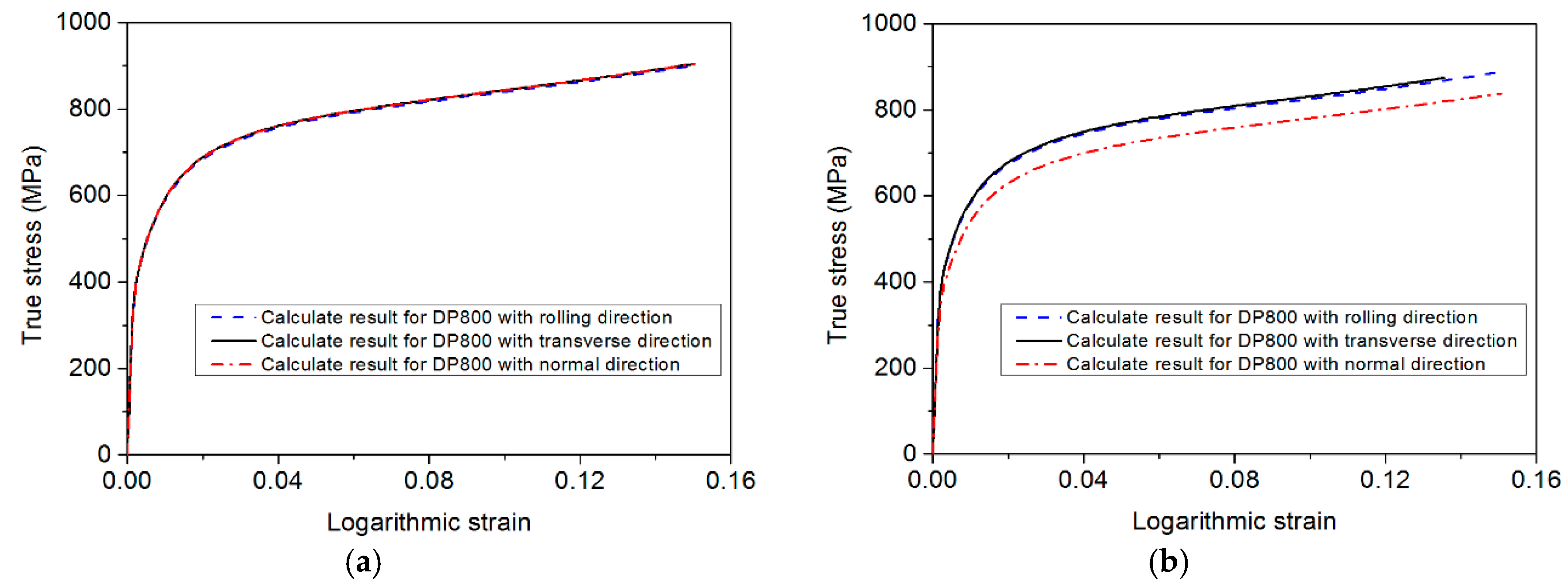


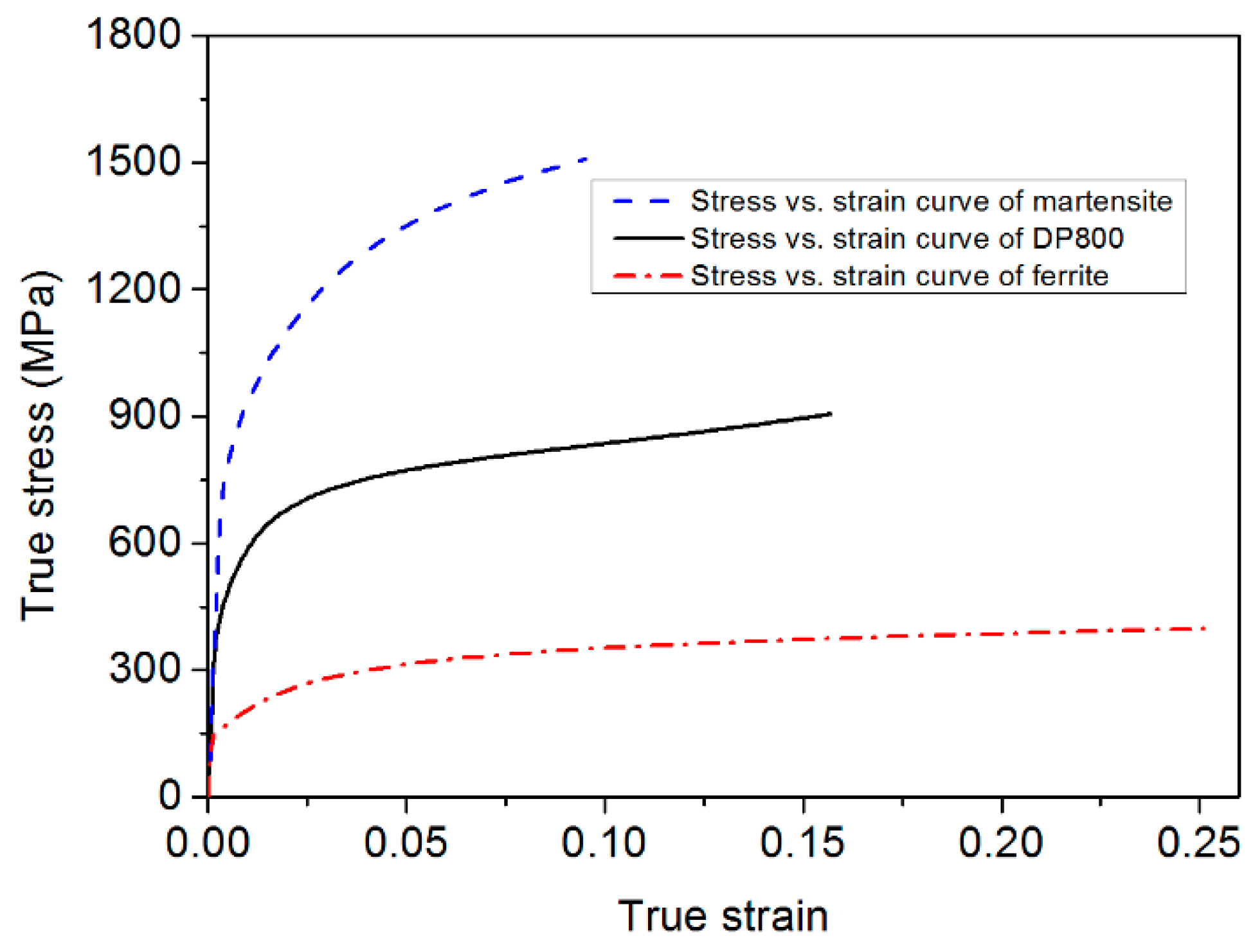
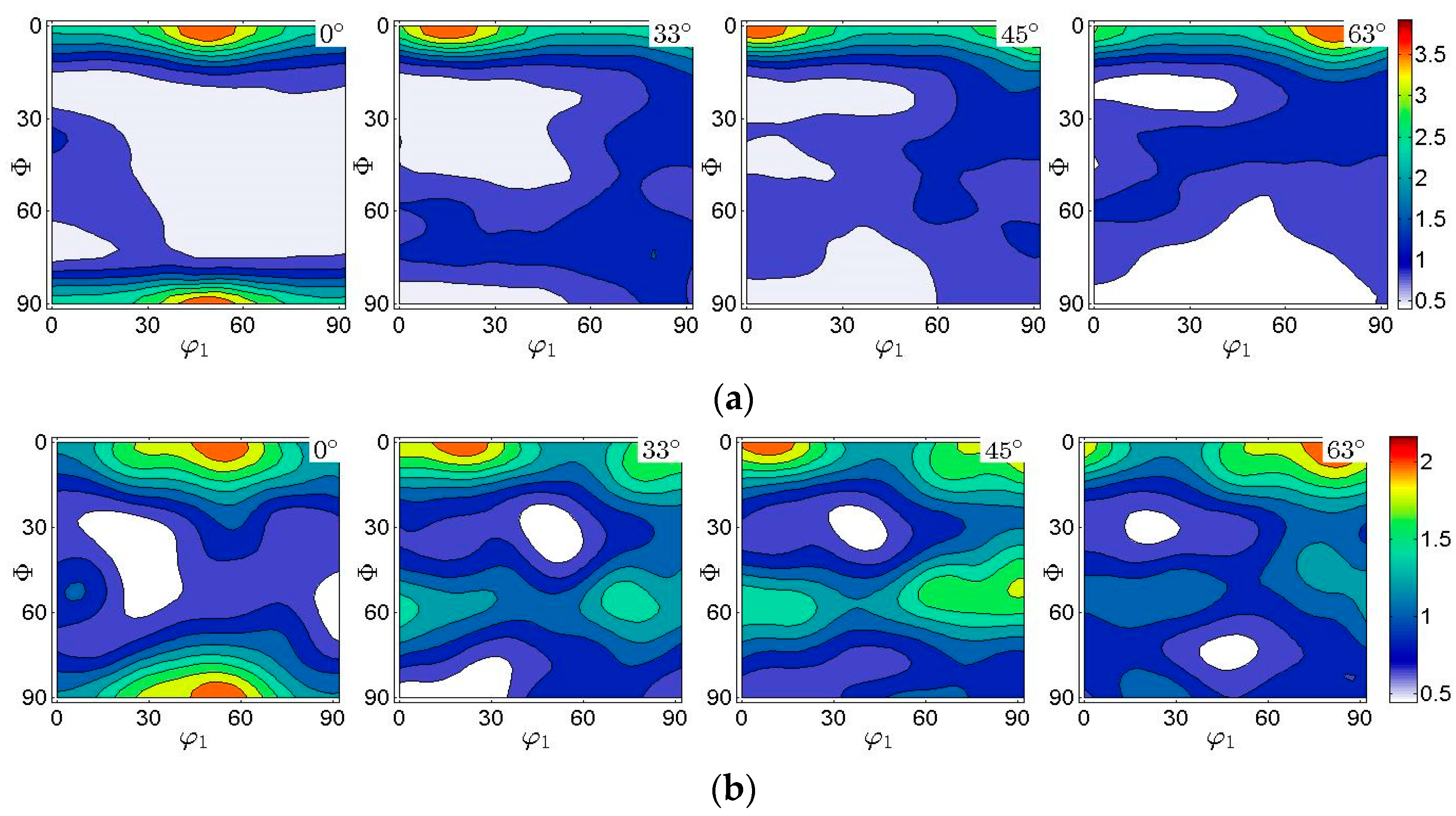

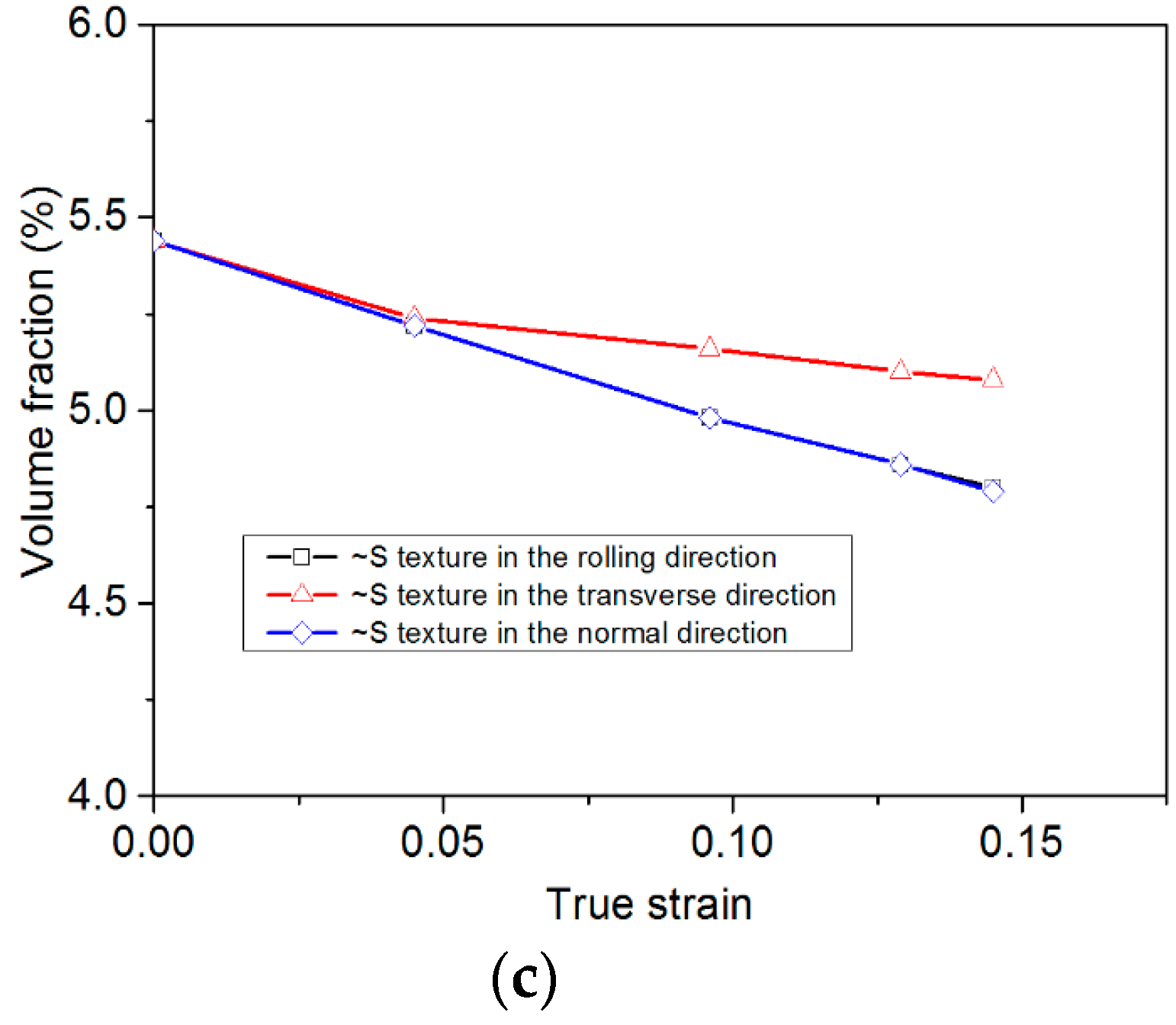

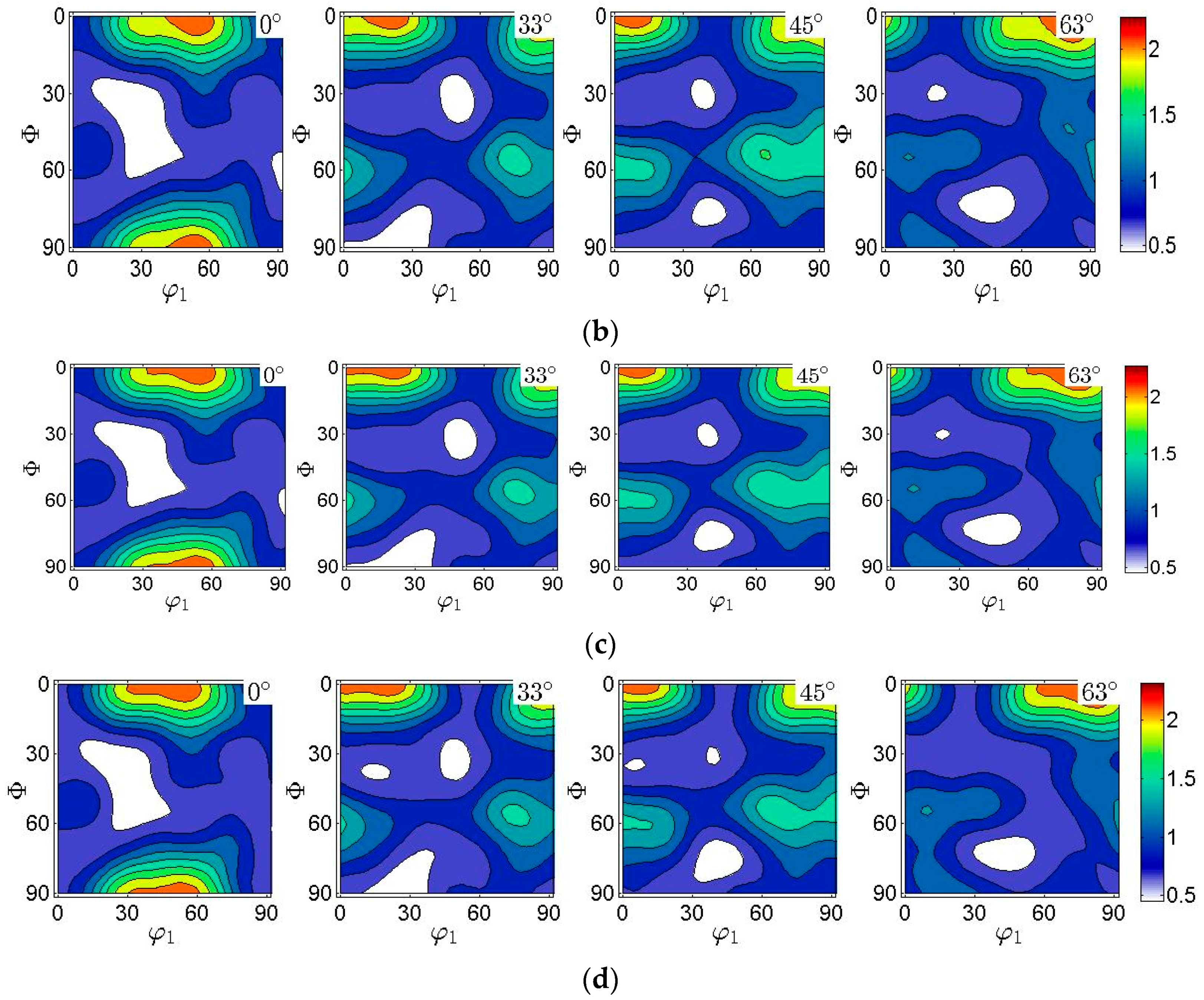
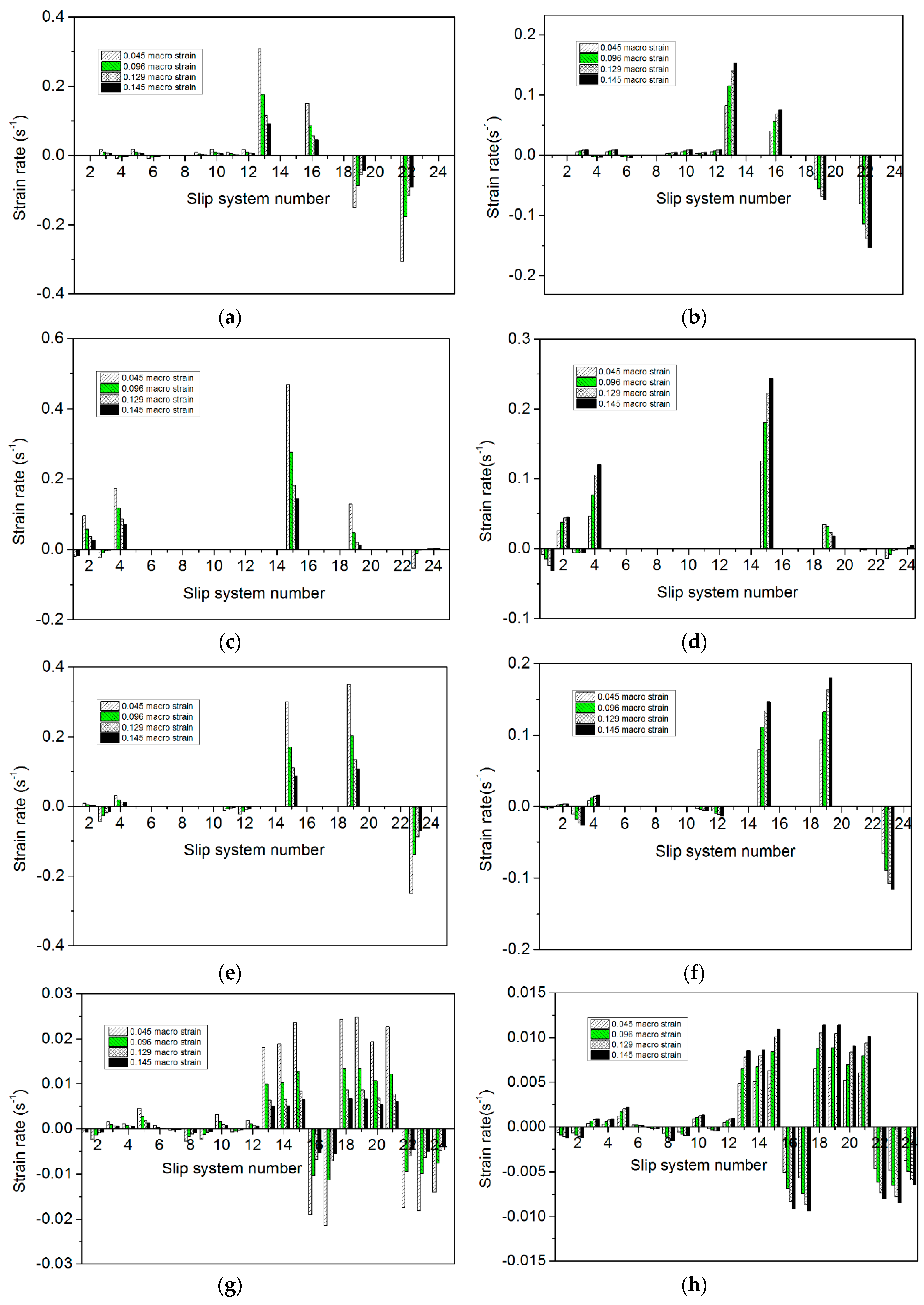
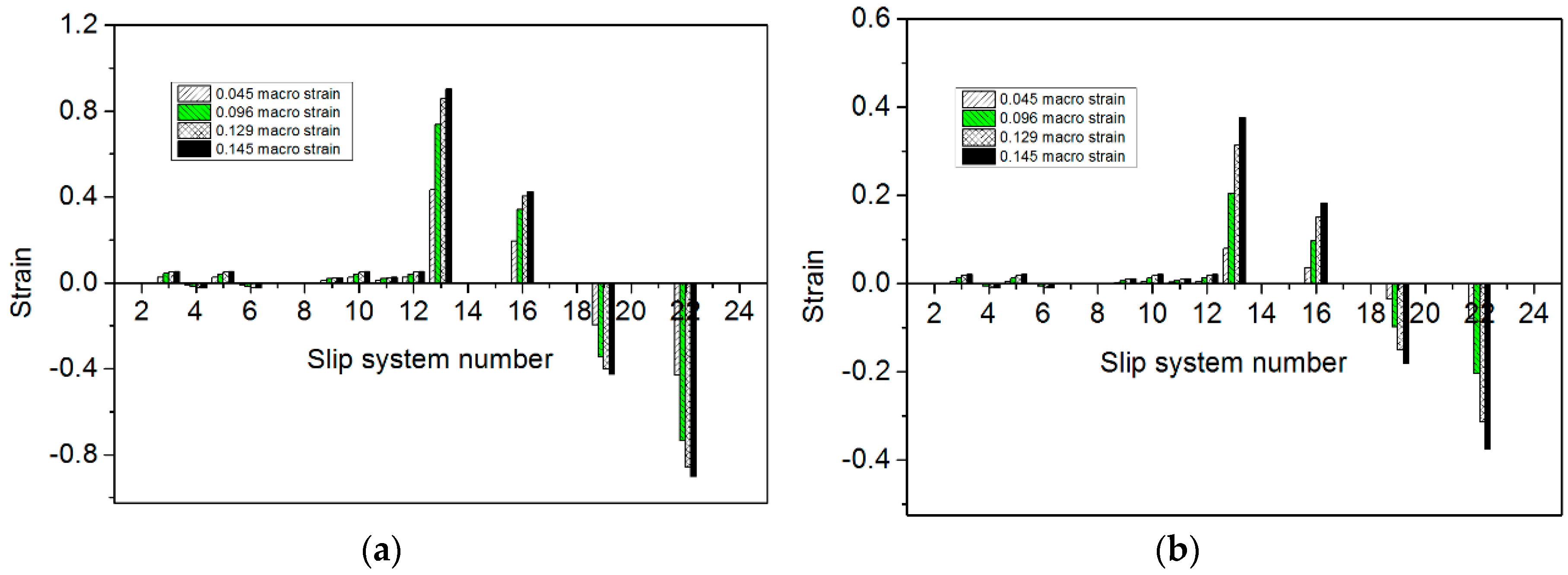

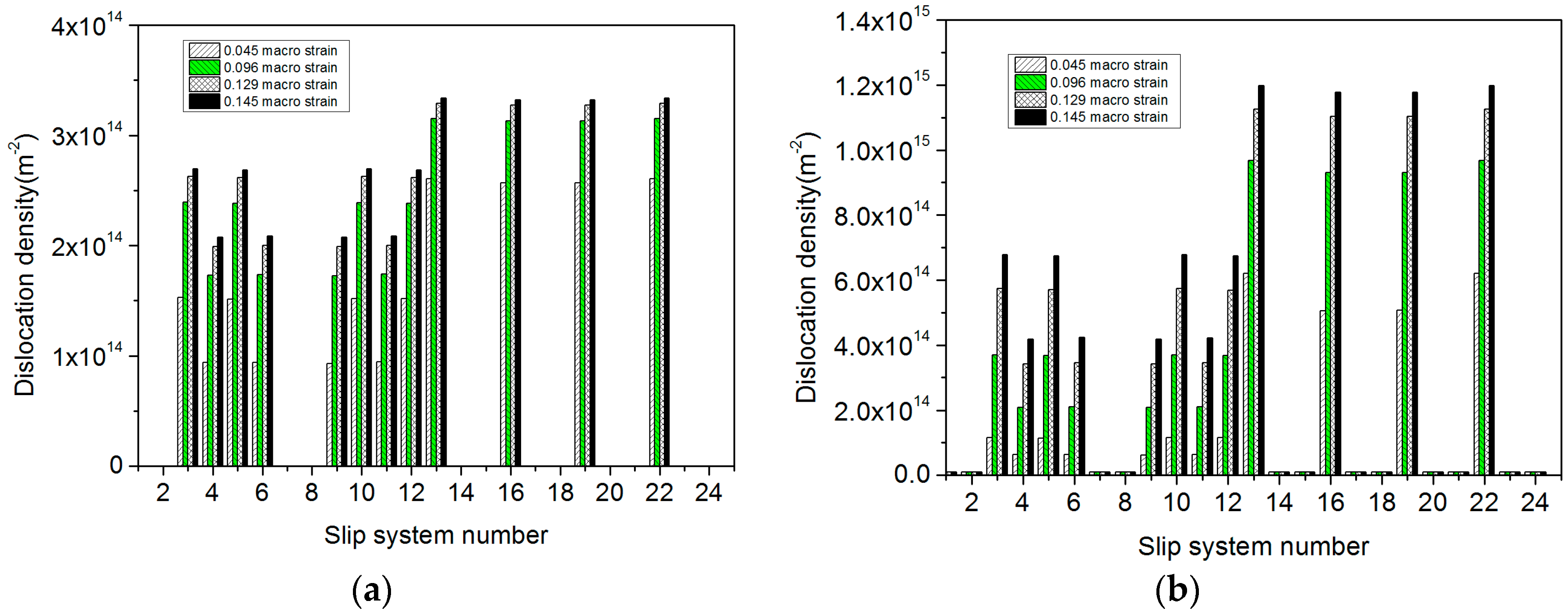

| Element | C | Cr | Cu | Mn | Mo | Ni | P | Si | S |
|---|---|---|---|---|---|---|---|---|---|
| Content (wt. %) | 0.1658 | 0.0347 | 0.0061 | 1.514 | 0.0096 | 0.027 | 0.0123 | 0.1821 | 0.00172 |
| Material | YM a (GPa) | YS b (MPa) | UTS c (MPa) | TE d (%) |
|---|---|---|---|---|
| DP800 | 207 | 500 | 770 | 20 |
| Phase | Ferrite | Martensite |
|---|---|---|
| p1 | 1.04092 | −0.97854 |
| p2 | −4.18105 | 4.22 |
| Phase | Martensite | Ferrite |
|---|---|---|
| (internal friction term) | 250 MPa | 55 MPa |
| (initial dislocation density) | 1 × 1013 m−2 | 1 × 109 m−2 |
| B (Burgers vector) | 3.0 × 10−10 m | 2.5 × 10−10 m |
| G (shear modulus) | 98.4 GPa | 55 GPa |
| C11 (anisotropic elasticity constant) | 417.4 GPa | 233.3 GPa |
| C12 (anisotropic elasticity constant) | 242.4 GPa | 135.5 GPa |
| C44 (anisotropic elasticity constant) | 211.1 GPa | 118 GPa |
| Item | v (%) | K | α | R | yc (m) |
|---|---|---|---|---|---|
| Martensite | 46 | 1.1 | 0.2 | 1.1 | 3.6 × 10−8 |
| Ferrite | 54 | 2.5 | 0.2 | 1.1 | 3.4 × 10−8 |
| Texture Component | {hkl} <uvw> | φ1 | Φ | φ2 |
|---|---|---|---|---|
| Cube (C) | {001} <100> | 0 | 0 | 0 |
| Rotated cube (Rt-C) | {001} <110> | 45 | 0 | 0 |
| Copper (Cu) | {112} <111> | 90 | 35 | 45 |
| Brass | {011} <211> | 35 | 45 | 0 |
| Goss (G) | {011} <100> | 0 | 45 | 0 |
| S | {123} <634> | 59 | 37 | 63 |
| R | {124} <211> | 57 | 29 | 63 |
| ~S | {123} <111> | 75 | 37 | 63 |
| Rotated Goss (Rt-G) | {011} <011> | 0 | 90 | 45 |
| BRASS R | {236} <385> | 79 | 31 | 33 |
| {111} <112> | 90 | 55 | 45 | |
| {111} <110> | 0 | 55 | 45 |
| Number | 1 | 2 | 3 | 4 | 5 | 6 | 7 | 8 |
| Slip system | {1–10} <111> | {1–10} <11–1> | {10–1} <111> | {10–1} <1–11> | {01–1} <111> | {01–1} <–111> | {110} <–111> | {110} <1–11> |
| Number | 9 | 10 | 11 | 12 | 13 | 14 | 15 | 16 |
| Slip system | {101} <–111> | {101} <11–1> | {011} <1–11> | {011} <11–1> | {11–2} <111> | {1–21} <111> | {–211} <111> | {1–12} <–111> |
| Number | 17 | 18 | 19 | 20 | 21 | 22 | 23 | 24 |
| Slip system | {12–1} <–111> | {211} <–111> | {1–1–2} <1–11> | {121} <1–11> | {–2–1 1} <1–11> | {–1–1–2} <11–1> | {–121} <11–1> | {2–11} <11–1> |
© 2018 by the authors. Licensee MDPI, Basel, Switzerland. This article is an open access article distributed under the terms and conditions of the Creative Commons Attribution (CC BY) license (http://creativecommons.org/licenses/by/4.0/).
Share and Cite
Xu, Y.; Dan, W.; Ren, C.; Huang, T.; Zhang, W. Study of the Mechanical Behavior of Dual-Phase Steel Based on Crystal Plasticity Modeling Considering Strain Partitioning. Metals 2018, 8, 782. https://doi.org/10.3390/met8100782
Xu Y, Dan W, Ren C, Huang T, Zhang W. Study of the Mechanical Behavior of Dual-Phase Steel Based on Crystal Plasticity Modeling Considering Strain Partitioning. Metals. 2018; 8(10):782. https://doi.org/10.3390/met8100782
Chicago/Turabian StyleXu, Yongsheng, Wenjiao Dan, Chuang Ren, Tingting Huang, and Weigang Zhang. 2018. "Study of the Mechanical Behavior of Dual-Phase Steel Based on Crystal Plasticity Modeling Considering Strain Partitioning" Metals 8, no. 10: 782. https://doi.org/10.3390/met8100782




